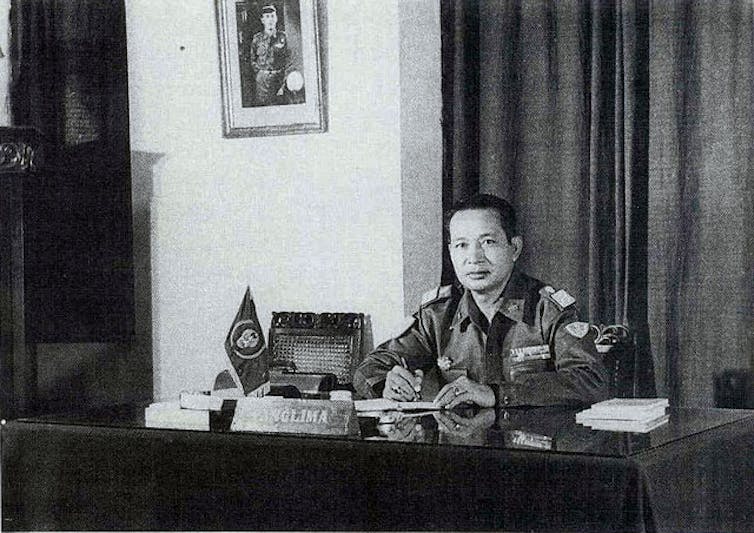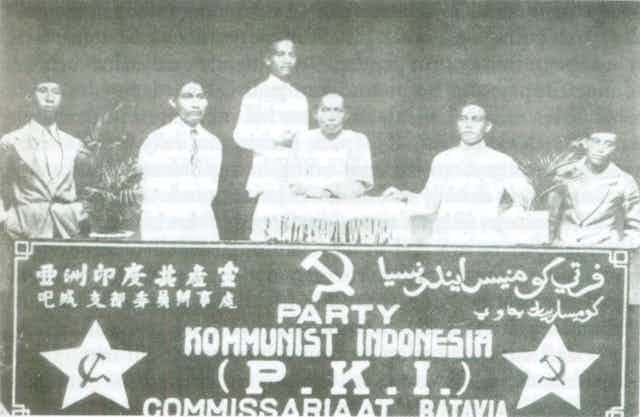In 1965, at the height of the Cold War, a communist victory in Indonesia seemed plausible. At the time, the Indonesian Communist Party was the third-largest in the world with three million members.
In that year, however, the systematic destruction of Indonesia’s Communist Party (PKI) began. The Indonesian army destroyed the party after a group calling themselves the “30th September Movement” kidnapped six generals in a botched attempt to weaken the army.
The movement involved a handful of top PKI leaders, but it was used as a pretext not only to ban the party but to conduct a massacre of party members that claimed half-a-million lives.
To this day, half a century later, communism is banned in Indonesia. The murders, torture and imprisonment of party members and their associates have never been accounted for.
Events of October 1
On October 1, 1965, Indonesians awoke to hear a radio announcement telling them that a “30th September Movement” had taken action to prevent a military coup and to secure the Indonesian president Sukarno’s position.
The movement’s leader, Lieutenant Colonel Untung, was commander of the presidential guard. He assured listeners that the president was safe, that “a number of generals” had been arrested and that a “Revolutionary Council” would shortly take responsibility for government.
People roughly knew who those arrested generals were. The army’s high command, led by General Ahmad Yani, in alliance with the defence minister, General A.H. Nasution, was locked in a political stand-off with Sukarno and the PKI, led by D.N. Aidit.
Who was behind the 30th September Movement?
The events of October 1 became a pivotal moment in Indonesia’s history. For decades, Indonesia observers treated the events of that day as a whodunnit. They assembled a list of suspects, assessed the meagre evidence against each of them, sought to divine their potential motives and came to a conclusion.
Not only Aidit and Untung featured in the line-up, but also Sukarno and General Suharto, who crushed the movement and replaced Sukarno as president. Sundry other characters such as the air force commander and the Chinese intelligence agency were also mentioned in these conspiracy theories.

After years of uncertainty, recent findings show the 30th September Movement was the product of months of planning by Untung, the PKI leader Aidit and a handful of others.
The movement aimed to throw the army high command off balance, discredit the generals as apparent enemies of Sukarno, and shift Indonesian politics to the left so that the PKI could come to power rapidly, though probably not immediately.
The movement happened at a precarious time in Indonesian politics. By 1965, the only significant powers at the centre of Indonesian politics were the president, the PKI and the army. Under Sukarno’s “Guided Democracy” presidential authority was supreme and all political players had to circle around him. But Sukarno’s failing health meant the system could not survive indefinitely.
The great uncertainty at the time was whether the party and the army would wait until Sukarno faltered before attempting to secure power, or whether either would seek an early advantage by launching a coup.
We may never know whether Yani, the army chief, had indeed planned a coup for later in October 1965, though we can be sure that the army high command had a range of contingency plans.
By presenting the movement as a defensive action by Sukarno loyalists, Aidit hoped to shelter the party from any rebuke for breaching the uneasy political stalemate. In August 1965, he outlined these plans to his friend, the Chinese leader Mao Zedong.
Untung’s desire to protect the president was sincere, but he became a stooge for Aidit.
Enter defiant Suharto
The disappearance of the generals did not throw the anti-communist forces in the army off balance. Instead, the relatively unknown General Suharto, commander of the army’s strategic reserve, took swift action.
Claiming military necessity, Suharto assumed army command. Within 24 hours, he cajoled and intimidated the movement’s troops in central Jakarta to surrender. He then seized the movement’s headquarters at Halim air force base, just south of the capital. There, a few days later, the bodies of the six kidnapped generals were found dumped in a narrow well.
Sukarno attempted to maintain political balance between the army and the party. On the afternoon of October 1, he appointed General Pranoto, one of the few senior generals not known to be anti-communist, as interim army commander.
Suharto, however, refused to give up his authority. In effect, the anti-communist Suharto replaced the anti-communist Yani, thwarting Aidit’s hope for a decisive shift to the left.
Army propaganda against the PKI
The murder of six generals was a shock to Indonesians.
There was little evidence of PKI involvement – the documents establishing Aidit’s role in the planning were discovered only decades later – but in the tense political environment people found the idea of a communist pre-emptive strike against its opponents plausible.
Suharto and his group quickly built on this shock. They falsely reported the generals were tortured and sexually mutilated by young communist women before being killed.
In the space of a few weeks, the military propaganda machine unfolded a story that the whole of the PKI was complicit in a massive conspiracy.
The propaganda claimed the murder of the generals was just the first step in a planned communist seizure of power that would include the murder of the party’s enemies on a far greater scale. Party members throughout the country were said to have been planning to murder their neighbours.
Rubbish pits were reinterpreted as makeshift graves, prepared in advance for the bodies of the PKI’s victims. Simple household utensils were reinterpreted as instruments of torture. These accusations underpinned the murder of perhaps half-a-million PKI members and associates over the course of six months.
Persistent conspiracy theories
Despite documents revealing Aidit’s role, some observers still support alternative theories for two reasons.
First, admitting Aidit’s role is sometimes seen as sailing perilously close to the Suharto regime’s justification of the massacres. However, there is a vast difference between acknowledging Aidit’s secret plans and subscribing to Suharto’s false claim that hundreds of thousands of communists were in on the plot.
Other theories also persist because there are niggling fragments of evidence that do not fit with a simple Aidit-Untung plot. For instance, Sukarno is reported to have warned a visiting Indian businessman to leave the country quickly because something was about to happen.
To understand these fragments we need to appreciate one of the cardinal laws of conspiracy: if there is one conspiracy, then there is probably more than one.
High stakes and tense circumstances typically push many political players to conspiratorial thinking. Sukarno, factions of the army, local and foreign intelligence bodies and perhaps even different factions in the PKI might all had their own plans, some of which have left us with perplexing evidence.
Nonetheless, there are two especially intriguing mysteries concerning the events of October 1 1965.
Did Western intelligence dupe Aidit?
First, did Aidit have real evidence of a planned generals’ coup later that month or was he deliberately deceived?
Western intelligence agencies deeply feared the PKI would come to power as Sukarno declined. They imagined a premature PKI grab for power would provide the pretext to defeat the party.
Did they find a channel to feed misleading information to Aidit that led him to plot the coup as a countermeasure?
We may discover the answer when Western intelligence files are finally opened – not likely to be in the lifetime of any of us. However, Jakarta was such a pungent stew of rumour and speculation in 1965 that it would be difficult to show that a Western intelligence intervention had decisively influenced PKI thinking.
Did Suharto know?
Second, did Suharto know more about the 30th September Movement plans than he ever admitted?

That Suharto was not among the generals who were kidnapped is not significant. He was generally considered non-political and would hardly have been involved in planning a coup.
We also need not take seriously the argument that Suharto’s highly effective seizing of the initiative after the disappearance of his commanding officers speaks to inside knowledge.
Military commanders are trained to react decisively, and a characteristic of conspiracies is that they often work to the advantage of those who react to them, rather than those who plot. Plotters typically find it hard to adapt their carefully laid plans to changing circumstances, whereas responders can improvise.
However, there is an important fact linking Suharto to the coup plotters. One of the movement’s leaders, Colonel Abdul Latief, was a close friend of Suharto. He spoke to Suharto on September 29 and again just hours before Untung’s forces set out to arrest the generals.
At his trial 13 years later, Latief claimed that at the first meeting, in Suharto’s home, he and Suharto briefly discussed the likelihood that senior generals were planning a coup. The second meeting took place in a Jakarta hospital, where Suharto was seeing to his son Hutomo, who had scalded himself with hot soup.
He claimed to inform Suharto that action was under way. “Having reported to him,” Latief testified:
I obtained moral support because there wasn’t any reaction from him.
Latief’s account of Suharto’s impassiveness rings true. Both before and after 1965, Suharto’s modus operandi was to keep his cards close to his chest and to move decisively at the last minute.
Latief’s information to Suharto may have been oblique and ambiguous, and it is uncertain what Suharto could or should have done at that moment. But Suharto was probably mentally prepared for action on the morning of October 1 in a way that none of his colleagues were.
Tragic end
The subsequent ease with which the communist party was destroyed showed how fragile it was in comparison with the army. A tattered economy along with old antagonisms between communism and Islamic groups, too, would have presented a PKI government with extraordinary difficulties.
A communist Indonesia was unlikely. That makes it all the more tragic then that the coup provided the pretext for the murder of half-a-million people.

